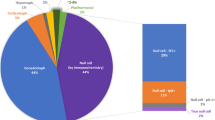Abstract
Objective To examine the utility of the GnRH (gonadotrophin-releasing hormone) test in the management of patients with pituitary and parapituitary lesions. Patients and Methods A 5-year retrospective study of LH (luteinizing hormone) and FSH (follicle stimulating hormone) responses to GnRH test in patients with HP (hypothalamic-pituitary) disease in a regional endocrine centre. Serum LH and FSH concentrations were measured at baseline and at 20 and 60 min after an intravenous bolus of 100 mcg (micrograms) of GnRH. The GnRH responses were categorised by tumour size, tumour type, and gonadal status. Results Of the 104 patients studied, 46 were male and 58 were female. There were 50 normal, 38 subnormal and 16 exaggerated LH responses compared with 34 normal 67 subnormal and three exaggerated responses for FSH. Seventy-four patients (71.2%) were hypogonadal. Normal LH responses were achieved in half of the hypogonadal subjects and normal FSH responses in more than a third. Furthermore, the LH responses were exaggerated in nine hypogonadal patients compared with three for FSH. The GnRH test could not differentiate between pituitary or parapituitary lesions either by size or type of lesion. An exception was the male non-functioning adenoma (NFA) sub-group (10 patients, all were hypopituitary, seven were hypogonadal), which demonstrated significant subnormal LH and FSH responses compared with other male and female tumour type sub-groups. Conclusions The data from this study indicate that the GnRH test is unhelpful in the clinical assessment of the HP axis in patients with HP disease.

Similar content being viewed by others
References
Coscia AM, Fleischer N, Besch PK, Brown LP, Desiderio D (1974) The effect of synthetic luteinizing hormone-releasing factor on plasma levels in pituitary disease. J Clin Endocrinol Metab 38:83–88
Lamberton RP, Jackson IM (1983) Investigation of hypothalamic-pituitary disease. Clin Endocrinol Metab 12:509–534
White WF, Schally AV, Baba Y, Arimura A, Redding TW (1971) Evidence for peptide nature of LH and FSH-releasing hormones. Biochem Biophys Res Commun 42:50–56
Schally AV, Nair RM, Redding TW, Arimura A (1971) Isolation of the Luteinizing hormone and follicle-stimulating hormone-releasing hormone from porcine hypothalami. J Biol Chem 246:7230–7260
Schally AV, Arimura A, Kastin AJ et al (1971) Gonadotropin-releasing hormone: one polypeptide regulates secretion of luteinizing and follicle-stimulating hormones. Science 173:7036–7038
Besser GM, McNeilly AS, Anderson DC et al (1972) Hormonal responses to synthetic luteinizing hormone and follicle stimulating hormone-releasing hormone in man. BMJ 3:267–271
Newton JR, Kilpatrick MJ, Pike JM, Collins WP (1975) An evaluation of the diagnostic value of synthetic luteinizing hormone releasing hormone. Acta Endocrinol 80:417–428
Westwood ME, Butler GE, McLellan AC, Barth JH (2000) The combined pituitary function test in children: an evaluation of the clinical usefulness of TRH and LHRH stimulation tests through a retrospective analysis of one hundred and twenty-six cases. Clin Endocrinol 52:727–733
Mortimer CH, Besser GM, McNeilly AS et al (1973) Luteinizing hormone and follicle stimulating hormone test in patients with hypothalamic-pituitary-gonadal dysfunction. BMJ 4:73–77
Hashimoto T, Miyai K, Uozumi T et al (1975) Effect of prolonged LH-releasing hormone administration on gonadotrophin response in patients with hypothalamic and pituitary tumours. J Clin Endocrinol Metab 41:712–716
Vierhapper H (1985) LH-RH stimulated LH secretion in human endocrine disease. Acta Endocrinol Suppl 269:3–25
Dash RJ, Sialy R, Rao NS (1985) LH and FSH responses to GnRH in health and disease. J Steroid Biochem 23:823–826
Chanson P (2000) Gonadotroph pituitary adenomas. Ann Endocrinol 61:258–268
Pavord SR, Girach A, Price DE et al (1992) A retrospective audit of the combined pituitary function test, using the insulin stress test, TRH and GnRH in a district laboratory. Clin Endocrinol 36:135–139
Snyder PJ, Reitano JF, Utiger RD (1975) Serum LH and FSH responses to synthetic gonadotropin-releasing hormone in normal men. J Clin Endocrinol Metab 41:938–945
Wentz AC, Jones GS, Rocco L, Matthews RR (1975) Gonadotropin response to luteinizing hormone releasing hormone administration in secondary amenorrhoea and galactorrhea syndromes. Obstet Gynecol 45:256–262
Grossman A (1998) Neuroendocrine control of pituitary function. In: Grossman A (ed) Clinical endocrinology, 2nd edn. Blackwell Science Ltd
Paja M, Lucas T, Garcia-Uria J et al (1995) Hypothalamic-pituitary dysfunction in patients with craniopharyngioma. Clin Endocrinol 42:467–473
Adan L, Bussieres L, Dinand V et al (2000) Growth, puberty and hypothalamic-pituitary function in children with suprasellar arachnoid cyst. Eur J Pediatr 159:348–355
Foppiani L, Piredda S, Guido R, Spaziante R, Giusti M (2000) Gonadotropin-releasing hormone-induced partial empty sella clinically mimicking pituitary apoplexy in a woman with a suspected non-secreting macroadenoma. J Endocrinol Invest 23:118–121
Matsuura I, Saeki N, Kubota M, Murai H, Yamaura A (2001) Infarction followed by haemorrhage in pituitary adenoma due to endocrine stimulation test. Endocr J 48(4):493–498
Author information
Authors and Affiliations
Corresponding author
Rights and permissions
About this article
Cite this article
Chammas, N.K., Chambers, S.M. & Harris, P.E. The GnRH test in the assessment of patients with pituitary and parapituitary lesions: results of a 5-year retrospective study. Pituitary 11, 271–278 (2008). https://doi.org/10.1007/s11102-008-0124-4
Published:
Issue Date:
DOI: https://doi.org/10.1007/s11102-008-0124-4




